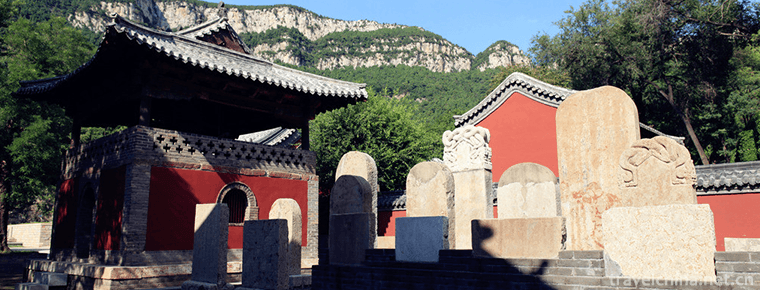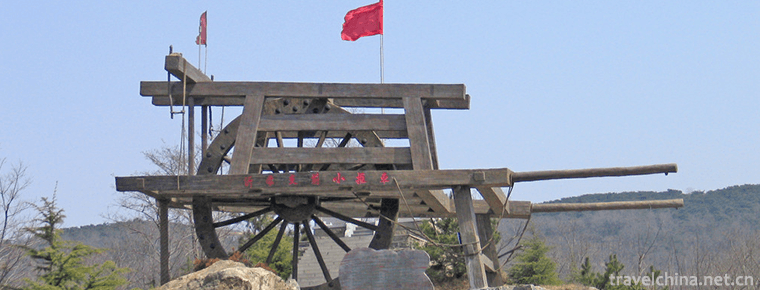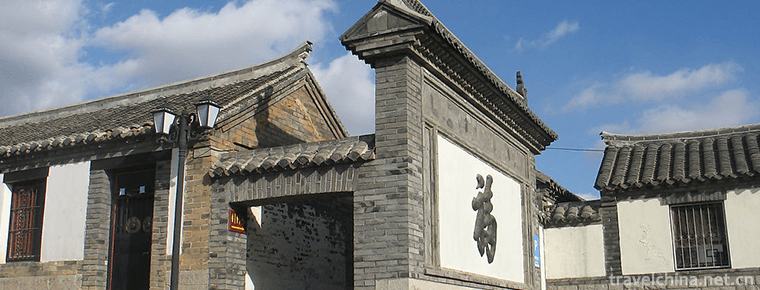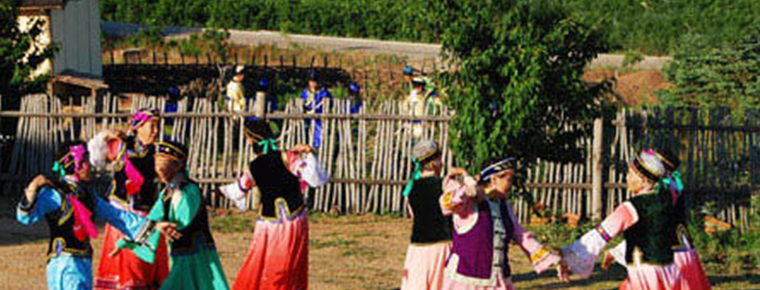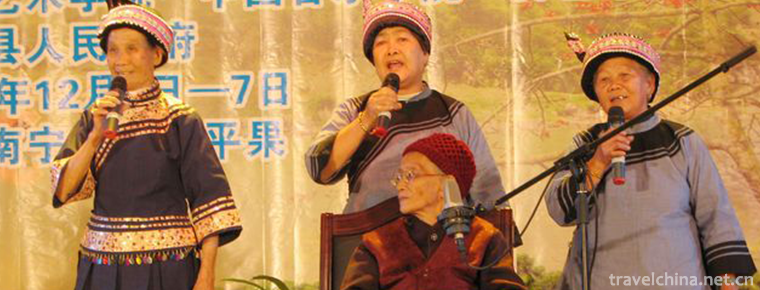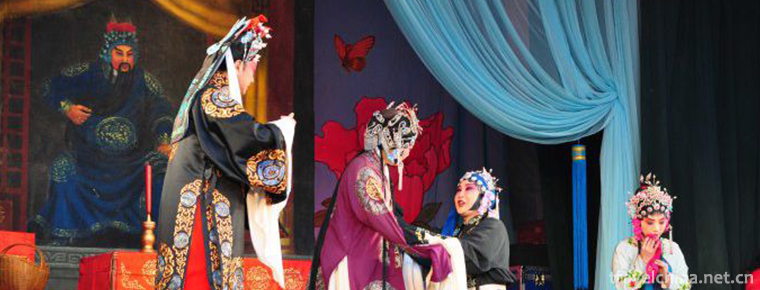Castle Peak Pass Scenic Spot
Castle Peak Pass Scenic Spot
Qingshankuan is located in the north of Qianxi County, 40 kilometers away from the county town, located in the Yanshan branch, the hinterland of Daqingshan Mountain. The Great Wall has been winding through since then. In addition, the ancient castle is built on the platform at the foot of the mountain, so it is called Qingshankuan Pass.
Qingshankuan ancient castle is only a well-preserved modern building in the 15 gates of Qianxi County. Except for natural collapse, few people have destroyed it artificially.
Qingshan Guancheng is 1.8 Zhang high, 1.4 Zhang closed and 166.9 Zhang perimeter. It was built in Hongwu period of Ming Dynasty.
Guancheng is magnificent and magnificent, with ancient fragrance and antique color, border garrison culture and strong customs of folk valley. The castle is now inhabited by some descendants of officers and men who were stationed here in ancient times. For hundreds of years, they have embodied the legacy of their ancestors in production, life and other activities.
The ancient castle in the Ming Dynasty has the Ming Dynasty Qijun Academy Military Yard, Guandi Temple, inn, tea house, wine shop and so on. These historic sites are rich in connotation, together with the human and natural landscapes inside and outside the castle, forming a multi-dimensional combination of resources.
Great Wall at Qingshan Pass
The Great Wall of Qingshan Pass was built in Wanli of Ming Dynasty. It has a history of 500 years. It has experienced wind, rain, war and chaos, but it is well preserved. The Great Wall at Qingshankuan has two unique enemy buildings. One is the prison building, which is used to imprison prisoners of war in ancient times. The building has no doors and only four-eye ventilation holes. It is one of the unique buildings of the Great Wall in China. The second is the 72 coupon building, which has 72 arches in size and has a unique and beautiful shape. Among the several enemy buildings, there are two odd buildings, namely the Fox Fairy Building and the Mingyue Building, which are built on the top of the mountain. It echoes the Bamianfeng. In addition, a water gate is kept here.
Prison Building
Looking southeast from Guanguan City in Qingshan, there is a special enemy building, called prison building, halfway up the Southeast mountain.
As the name implies, the prison building is a fortress for prisoners of war in ancient times. There is only one stone gate in this building, and there are several air vents above it. The building is about 30 square meters and can stand side by side for 40 people. Therefore, if the enemy is captured in battle, he will push through the stone gate and then block it with heavy stones. Because the air vent is one foot and eight feet away from the ground, its walls are smooth and can not be climbed. Once the enemy is captured, it will never escape. It is said that after being captured, the prisoners of war were pushed into this building without water, and died of hunger and thirst a few days later. Therefore, all prisoners of war in this building were desperate, crying endlessly, and their tragic scenes were conceivable. According to local people's rumors, on a dark and windy night, ghosts cry and wolves howl in the prison building, which is scary.
The prison building is no longer a prisoner of war, but a visitor. Here is a record of years of constant fighting, feats of breaking through the enemy in dangerous and strange passes, as well as the humiliation of abandoning cities and selling cities. Wind, snow, frost, sword and shadow in North China have created a magnificent mansion. Now, in the shade of ancient trees and flowers, the prison building is like a sleeping strong man, thinking silently about the end of history.
Seventy-two Securities Building
On the top of the Great Wall on the south side of Qingshan Pass, there is a peculiar enemy building, 72 coupon buildings. The second building is built across the city wall and consists of three parts: the upper, middle, lower and lower parts: the lower part is the base, which is made of large stones, and the height is the same as the city wall. The middle floor is a hollow part with a small corridor structure. The south wall and the north wall each have a stone coupon door, which is located on the west side of the two arrow windows. There are four arrow windows in the east wall and two arrow windows in the West gun. There is a lookout under each arrow. The building is relatively spacious for soldiers to live in, store food and artillery, ammunition, bows and arrows and other weapons. On the internal structural wall, there are many arched "closets" for garrison soldiers to place objects. The middle level is also where soldiers fight.
Along the west side of the building, only one person can walk through the brick staircase to the top of the building. In the center of the roof, there is a ramp, on which there is a roof building, surrounded by stacks, for soldiers to guard, look at the enemy, shelter from the wind and rain. The building is now destroyed.
The windows, doors, ladders, lookouts, structural walls, closets and sentry buildings on the roof of the building are 72 coupon arches, hence the name of the building. This building has brick and stone vouchers, which are ingeniously combined, beautiful in shape, and unique in one. No enemy building with the same shape has been found along the Great Wall, which is unique. This building was built by Qi Jiguang, General Officer of Jizhen in Ming Dynasty.
In addition to the peculiar shape, there is another peculiarity in the 72 coupon buildings: if the rumor goes to the building early on the day of stunning, when the first ray of sunshine comes in from the arrow window, there will be music characters on the roof of the building. It is said that these characters can predict the trend of the rainwater in that year, so the local people also call them "Water God Tower".
Standing in front of 72 coupon buildings, you will feel the greatness of the Great Wall, the magic of this building, the wisdom of the ancients, the vicissitudes of history!
Moon tower
On the evening when the moon is shining, standing at the foot of the green hill and looking up to the north, you will see a pale shadow of an enemy building in the dark shadows rising into the night sky. She stands quietly on the top of the peak, and the bright moonlight gives her a layer of vague light. At this time, there may be a breeze coming from the direction of the building like a fish, in this slight movement, the viewer seems to hear the faint singing on the first floor, a strange relaxation and comfortable moment to swim all over the body...
That building is the Moon Tower.
The Moon Tower is one of the more complete enemy buildings of the Great Wall. It is situated at the summit of more than 800 meters above sea level, facing the abyss of 10,000 Zhang in the north, with steep rock and straight up like cutting, and lush vegetation and thorns in the south. At 50 meters west, there is a peak standing abruptly, bony and dangerous. The whole building is square, 15 meters high, 10 meters long from east to west and 10 meters wide from north to south. All of them are blue brick and white stone structures. The foundation is made of square strips of stone. The largest one is about 3 feet long, 1 feet wide, 2 feet thick, weighing about 0.8 tons, and the smallest one is about 0.5 tons. What's more amazing is that these cornerstones are all artificially carved from the right, with shallow chisel marks and sharp edges and corners. Faced with these thick cornerstones, it seems that we can see a burst of "jingling" sound passing through the history of runaway ringing to us. The main building above the stone foundation is made of green bricks. Only two East-West doors and eight windows inlaid in four walls are still framed with stones, inclusive of the wind and the moon, throughput and flow. In the middle of the building, there are green bricks biting each other to build the roof, so that the whole building presents a thick, solid style. Standing downstairs, facing this ancient and simple enemy building directly, her solemnity will make the gazers equally solemn, and her magnanimity will make the gazers equally heavy. Once in the building, even in the hot summer, there will be a cool feeling to the bottom of my heart. Looking out from the window, the mountains and peaks are flat, and you can see them all, your mind is open, your worldly thoughts and all kinds of sorrows disappear in the distance, but you don't know how to return.
The Moon Tower is a magnificent and simple enemy building, but it has a poetic and romantic name. Is it true that there is a kind of tenderness melting in the green bricks and white stones under the cover of perseverance and bravery? There are many versions of the legend about the origin of this beautiful name. On the one hand, when the building and ridge are quiet at night, living alone in the building, the first floor of the building is full of moonlight and stars, which makes people feel like they are in the fairyland of the Moon Palace, so the Moon Tower gets its name; on the other hand, it is legendary that when they climb to the Moon Tower on a clear morning, they can clearly see a red sun rising slowly from the eastern depression, and at this time, a bright moon still hangs above the building. Sun and moon are shining together, it seems that the bright moon is reluctant to leave the building; there is also a romantic and mysterious saying: every year on the full moon night of the Mid-Autumn Festival, when the birds are tired and quiet, the moonlight turns, the breeze is like water, a group of fairies fluttering down from the Moon Palace, landing on the Moon Tower lightly and gracefully, playing with jade, dancing gracefully, and blending with the fairy world... The content of the legend may be nihilistic, but the legend is never created out of thin air. It embodies people's infinite yearning for a better life. No wonder, besides the legend, there is also a local saying: climbing the Moon Tower, all things do not know sorrow...
Modao "When will the moon be"? Please come to the Moon Tower. The Moon Tower will let you appreciate the poetic and romantic feelings, while expressing the pride of "nine days for the moon".
Eight face peak
Located in Qingshankou Village, Shangying Township, Qianxi County, at 842 meters above sea level, it is the first peak in eastern Hebei Province. Because the mountain body is octagonal, it is called octagonal peak.
Bamianfeng, covering an area of about 160,000 square kilometers, has a East-West trend. It is composed of Archaean gneiss. The surface soil is mostly grass-brown soil and cinnamon soil. It's famous for its steep mountains and rocky rocks. It's covered with trees and sunshine. Birds are singing euphemistically. On cloudy and sunny days, or foggy hillsides, or clouds around the peaks; sometimes the mountains are like gauze, sometimes the sunshine is magnificent, it is really a good place to explore and climb, especially on the top of the mountain to watch the sunrise has a strange scene.
Bamianfeng is not only beautiful in scenery, but also rich in special products. The mountains are densely vegetated with pine, oak, chestnut, peach and many other trees. There are Yuanzhi, Yuanhu, Huangqin, Salvia miltiorrhiza and other wild Chinese herbal medicines, as well as chestnut mushrooms, dragons, Ganoderma lucidum and other mountain treasures. During the War of Resistance Against Japan, the Eighth Route Army of Eastern Hebei, under the cover of the mountains, launched a tenacious revolutionary struggle with the Japanese puppet army. With selfless mind, Bamianfeng devotes its love and affection to people year after year.
Pinus Taiping
On the roof of an enemy building on the north side of Shuimen, there grows a green life, Taipingsong. The pine tree is not very big, but it has been more than one hundred years old. According to the village's 80-year-olds, in their childhood, they often went to this tree to pick pine balls, and that was what the pine tree looked like at that time. Because this pine grows in this special place on the top of the high enemy building, it is very noticeable and imaginative.
Instead of choosing fertile fields and windward slopes, this pine chose the enemy roof of the Great Wall. There is hardly any soil and water here. Some are only green bricks and lime. The conditions are bad and malnourished, so the sound factory is very slow. There are frontier fortress storms and cold frost and snow, but it can stand firm, straighten up waist poles, overcome various difficulties, and gradually exercise their branches such as iron, dry as copper, with a firm and unyielding character!
Today, the Great Wall has lost its defensive role and fulfilled its historical mission, and a green life grows on the roof of the enemy building. This pine tree, with its own green, tells people everyday that the past years of smoke and sword shadow have gone forever, and that it is a peaceful and happy era! _____________
Therefore, people call it "Taiping Song".
Pull the shaft
On the hillside outside the north gate of Castle Castle Qingshanguan, there is a well-known water well, the wrench well. This well is five feet deep, waterlogging year does not overflow, dry year does not dry up, well water is cool and sweet. When was this well repaired? There is no historical record, it can not be verified. It is said that when the city was built here in the early Ming Dynasty, the well had been laid for drinking water for the army.
Originally, the well inclined to the southeast by 20 degrees. There was a stone ladder on the south side of the well. It was very convenient to draw water directly along the stone ladder. This well is called "pull down well", which sounds rather magical. In our country, there are many legends of "pulling down wells" in many places, but most of the legends of "pulling down wells" in those places were pulled down by general Xue Li in white robe in the early Tang Dynasty during the Eastern Expedition of King Li Shimin of Tang Dynasty, or by Kangxi's private visit. The "pulling down well" of Qingshan Pass is said to have been pulled down by Qi Jiguang, a national hero, when he repaired the city. In order to commemorate Qi Jiguang's pulling down the well for the benefit of the people, people named the well Qi Jiguang pulling down the python, so as to spread from generation to generation.
Unfortunately, after the Japanese occupied Castle Castle at Castle Peak Pass in 1943, the "pull-down well" suffered as much as the people here. After the Japanese puppet army occupied the castle, the water storage of people relied on this "pull down well". But after a short time, the well suddenly dried up. The Japanese ordered the men to take down the "pull-down well" and dig several feet deep, then build the inclined well into a straight one. Although the well has water, it is muddy and bitter. After liberation, the well water became clearer and clearer, and the sweetness of the past was restored. Although this well is a straight one, people still call it "pulling down well" in memory of Qi Jiguang.
The water in the "pull-down well" is clear and thorough. This water surface is far higher than the "pull-down well" of the river below. It is not only a unique scenery, but also a bright mirror, which can always show people's hearts to the back.
Castle Peak Shuiguan
Shuimen, also known as Shuiguan, was built in October of the twelfth year of Wanli in Ming Dynasty. It is built on the east side of the castle, based on the cliff, with five layers of stone on the base and fifty-five rows of square bricks on the base. It is arched, eight feet wide and four feet high. Under the upper arch, it is beautiful in shape and without any decoration. It is simple and clear, simple and generous. Looking from afar, Shuimen Cave rises on the mountainside like a crescent moon. Though washed by wars and fires for more than 400 years, soaked by wind and rain, shaken by earthquakes, and washed by several torrents, it still stands tall and solid without changing its shape. Under the watergate, the rivers are murmuring all the year round, singing constantly, and the clear flow from the Watergate runs into the Xiaoqing River in Guannei.
According to historical records, the original copper gate of the water gate weighs up to a kilogram, and there are four big stone pillars on all sides of the gate floor, connecting the lever, and the gate can be lifted freely. When the enemy invades, it can lift the sluice and release water to stop the aggressors. In addition, the water gate can also play the role of flood discharge, drainage and restriction of pedestrians. In the thirteenth year of Qing Guangxu, mountain torrents broke out and the copper gates were washed away. According to local people's inference, because the Tongmen was too heavy, transportation was inconvenient at that time, it was impossible to be smuggled away, possibly buried in the river bed under the mountain. If excavated, it is a precious historical relic.
Entering Qingshan Pass
Qingshan Pass was built in Hongwu period of Ming Dynasty. The road was outside the Saibei grassland, and the inland was directly to Santun Camp of Jizhou Town Government. Its geographical position is very important, and it has always been an important military place for soldiers. The mountains on both sides of Guancheng are opposite to the arch, the peaks are overlapping with obstacles, and the Great Wall rises from the south, winding westward, making it even more dangerous and magnificent for Qingshan Pass, which has the tendency of "one man should close, one thousand men should not open". Shanhaiguan is the first pass in the world, while Qingshan Shuiguan is the first gate of the Great Wall. It is the only well-preserved lift-type gate along the Great Wall. Based on the cliff, five layers of stone are laid on the base, and fifty-five rows of square bricks are arched on the base. After 400 years of war and shaking by the earthquake, it still stands tall.


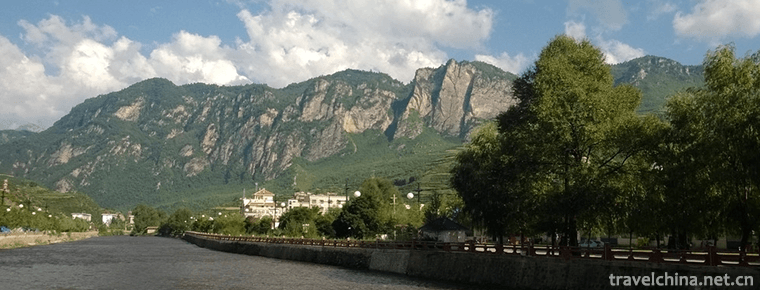
-
Tiananmen Square
East Chang'an Avenue, Dongcheng District, Beijing, China.
Views: 316 Time 2018-10-02 -
Jinjiang Amusement Park
Jinjiang Paradise is the first large-scale modern amusement park in Shanghai, China. It covers an area of 170 Mu and has 40 amusement projects. It is suitable for tourists of all ages. It receives abo.
Views: 202 Time 2019-01-29 -
Lingyan Temple in Jinan
Lingyan Temple, built in the Eastern Jin Dynasty, has a history of more than 1600 years. Located in the north foot of Mount Tai in the southwest of Jinan City, Shandong Province.
Views: 246 Time 2019-02-03 -
Meng Lianggu Tourist Area
Meng Lianggu Tourist Area is located at the junction of Mengyin County and Yinan County, Linyi City, Shandong Province. It belongs to the Mengshan Mountains System. It is said that Meng Liangzeng, a g.
Views: 290 Time 2019-02-07 -
Qixia Mous Manor
Mou's Manor, also known as Mou Erhei Manor, is located in Ducun, an ancient town in the north of Qixia City (the northern head of the original Xiaguang Third Road)..
Views: 151 Time 2019-02-07 -
Daur Ruzhigle Dance
"Luzhigle" is a representative folk dance of Daur nationality. It varies from place to place, including "Alhambo", "Langtudabe", "Hakumai", "Hagen Melger&q.
Views: 103 Time 2019-04-22 -
Fengyang flower drum
Fengyang flower drum is also known as "flower drum", "beating flower drum", "flower drum gong", "double drum" and so on. Fengyang flower drum originated in Linh.
Views: 330 Time 2019-04-29 -
Hangzhou Reviews
Hangzhou Ci Commentary, commonly known as Xiaoshu, is the traditional art of rap and singing in Hangzhou, Zhejiang Province. It is a kind of folk art that tells stories.
Views: 189 Time 2019-05-02 -
72 Sorcery Music of Lingyun Zhuang Nationality
The 72 witchcraft tunes of Lingyun Zhuang nationality originated in Lingyun County, Guangxi, mainly centered on Sicheng Town, where the county government is located. It is a tune sung by the Zhuang wi.
Views: 181 Time 2019-05-13 -
Qu Opera
Opera is one of the traditional operas mainly spread in Henan Province. It was also called "Gaotai Opera" or "Quzi Opera" in the old days. Quju is popular in Henan Province and its.
Views: 86 Time 2019-06-11 -
Chongzhou jiulonggou scenic spot
Chongzhou jiulonggou scenic spot is located in Sanlang Town, Chongzhou City, with an area of more than 170 square kilometers and 76 kilometers away from Chengdu City. Jiulonggou is known as "Dragon Palace on earth". .
Views: 303 Time 2020-11-05 -
Yibin scenic spot
South Sichuan Bamboo Sea is a national AAAA tourist attraction, covering an area of 120 square kilometers and a core scenic area of 44 square kilometers. There are eight main scenic areas, two major scenic spots and 134 scenic spots. In 2009, it was se.
Views: 362 Time 2020-12-18


